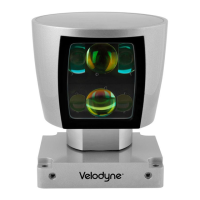High Definition LiDAR Sensor
Velodyne LiDAR, Inc.
©
2019
Appendix G: Ethernet Timing Tables
The sensor Ethernet timing tables show how much time elapses between the actual capturing of a point’s
data event and when that point is an event output from the sensor. By registering the event of the
Ethernet data capture, you can calculate back in time the exact time at which any particular distance point
was captured. The formula is as follows:
Actual Event Timestamp = (Data Packet Event Output Timestamp)
—
(Timing Table Event Timestamp)
The upper block and lower block collect distance points simultaneously with each block issuing single
laser pulses at a time. That is, each upper block laser fires in sequence and in unison to a corresponding
laser from the lower block.
For example, laser 32 fires simultaneously with laser 0, laser 33 fires with laser 1, and so on.
The sensor has an equal number of upper and lower block returns. This is why when interpreting the
delay table each sequential pair of data blocks represents the upper and lower block respectively, and
each upper and lower block pair of data blocks in the Ethernet packet has the same delay value.
Ethernet packets are assembled until the entire 1200 bytes have been collected, representing six upper
block sequences and six lower block sequences. The packet is then transmitted via a UDP packet over
Ethernet. See a sample of the packet format in Appendix E.
Sensor Ethernet Transmit Timing Tables
Ethernet Output Duration 100 µs
Total Packet Bytes 1248
Header Bytes 42
Data Bytes 1200
Footer Bytes 6
Byte per microsecond 12.48
Microseconds per Byte 0.08013
How to Use the Timing Tables
The table on the following page is the dual return laser firing time table. The laser firing time is referred to
when the data packet starts to transmit over Ethernet.
NOTE: It takes about 100µs to transmit the entire 1248 byte Ethernet packet. This is equal to 12.48
Bytes
/µs
and 0.080128µs/Byte. This number may vary depending on Ethernet speed

